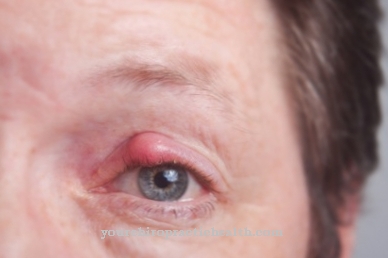A Arsenic intoxication is poisoning with the chemical element arsenic. Arsenic is a semi-metal and one of the trace elements. Poisoning is usually caused by trivalent soluble arsenic.
What is arsenic intoxication?

© Andrey Milkin - stock.adobe.com
Trivalent arsenic compounds are highly toxic as they disrupt transport processes within the body, hinder DNA repair and negatively affect cellular energy metabolism. Arsenic poisoning can occur acutely or take a chronic course. Arsenic was already used medicinally in ancient times.
It was part of the therapy for syphilis. In the form of the very poisonous arsenic, arsenic became known as a murder weapon and suicide agent. Arsenic is one of the trace elements. So it seems to take on useful tasks in the body in small doses. The function of arsenic in physiological doses has not yet been clarified.
causes
Acute arsenic poisoning occurs when large amounts of arsenic suddenly enter the body. A dose of 60 to 170 milligrams of arsenic can be fatal to humans. However, chronic arsenic intoxication is more common than acute arsenic intoxication.
Arsenic pollutes drinking water in many countries in the form of arsenite or arsenate. The arsenic gets into the groundwater through the leaching of ores containing arsenic. Around 100 million people worldwide have access to arsenic-contaminated water. In India, Thailand and Bangladesh in particular, chronic arsenic poisoning can be observed to an increasing extent due to these circumstances.
The World Health Organization (WHO) recommends that an arsenic value of 10 micrograms per liter in drinking water should not be exceeded. In Germany this value has been maintained since 1996. However, many other European countries and the USA regularly exceed this limit.
Rice is one of the foods that is most heavily loaded with arsenic. The arsenic from the groundwater accumulates around ten times as much in rice as in other types of grain such as wheat or barley. Apple juice and beer are also often contaminated with arsenic. Soluble arsenic compounds are absorbed through the gastrointestinal tract and also through the skin. The arsenic is then stored in muscles, skin, hair, nails, bones and in the lungs.
Symptoms, ailments & signs
The acute arsenic intoxication is already noticeable a few hours after intake. Severe gastrointestinal inflammation occurs with vomiting, severe pain, nausea and severe watery diarrhea. This causes the body to lose a lot of water and salt. The blood thickens and the function of the kidneys is restricted.
The pulse increases to compensate. Those affected suffer a shock within a short time. Death occurs within a few hours to days from kidney failure or cardiovascular failure. The picture of chronic arsenic poisoning is very diverse. Characteristic of the poisoning is a strong callus formation on the soles of the feet and on the skin surfaces.
Dark gray skin pigmentation and white bands on the fingernails are also typical. In addition, the affected person's hair falls out. It can lead to inflammation of the conjunctiva. The brain and nerves can be damaged. The consequences are disorders of sensitivity, movement disorders, paralysis or regression of the muscles.
The sick are tired, dull and suffer from lack of drive and lack of concentration. The airways are damaged as well as the liver. Long-term exposure to arsenic can damage the small blood vessels. The resulting undersupply of oxygen is initially shown by drumstick fingers and watch glass nails.
In extreme cases, the affected regions or even the entire extremities die. This medical phenomenon is also known as black foot disease. Chronic exposure to arsenic also increases the risk of cancer. After a few years, malignant growths of the skin, liver, lungs, or urinary bladder can appear.
Diagnosis & course
Arsenic intoxication can be detected by measuring the arsenic blood level. In the event of intoxication, arsenic can also be found in the urine. Evidence is provided by means of atomic absorption or atomic emission spectroscopy. Unexposed persons have an arsenic level in the blood of 5 to a maximum of 15 µg / l (micrograms per liter).
The concentration can rise slightly due to the excessive consumption of arsenic contaminated marine animals or plants and can be mistaken for a chronic arsenic intoxication. In people who are not exposed to arsenic in their professional environment, the concentration in the urine varies between 5 and 20 picograms per liter.
If food containing arsenic is consumed, the concentration can increase to up to 1000 picograms per liter. Because of these food-dependent fluctuations, chronic arsenic poisoning can be better diagnosed by analyzing hair or nails. Roughly speaking, a ten-fold increase in the concentration of arsenic in drinking water doubles the arsenic content in the toenails in the long term.
Complications
In acute arsenic poisoning - depending on the dose and the constitution of the poison victim - death is a likely consequence. The complications after chronic arsenic intoxication can vary in severity. The long latency period of up to thirty years is problematic.
Changes in the appearance of the skin, such as pigment disorders or increasing keratinization of the skin, are typical of chronic arsenic poisoning. As a complication of a long-term exposure to arsenic - for example through drinking water - severe disfigurements can result. In addition, the fine blood vessels in the legs can be permanently damaged.
This can go so far that the affected extremities die and have to be amputated. Initially, the affected legs turn black. Medicine calls this phenomenon "Black Foot Disease". Up to now, a limited region in Taiwan was known to develop such symptoms more frequently in the 1990s.
They were created by consuming arsenic contaminated groundwater. In recent times, however, the "Black Foot Disease" has also been diagnosed in countries where wine is grown. In addition to "Black Foot Disease", chronic arsenic intoxication can also cause cancer of the skin, lungs, liver or urinary bladder. Arsenic poisoning very rarely results in the neurogenic "Sudeck syndrome" or toxic heart damage.
When should you go to the doctor?
Arsenic intoxication must always be treated by a doctor. In acute emergencies, an emergency doctor should be called or the hospital should be visited directly. Arsenic intoxication is a very serious complaint that, in the worst case, can lead to irreversible damage to the organs and thus also to death. The doctor should be consulted if the person concerned has consciously ingested a large amount of arsenic. The patients suffer from diarrhea and severe abdominal pain. There is also vomiting and nausea.
If these symptoms are also associated with paralysis or movement disorders, a visit to the doctor is essential. A doctor must also be consulted in the event of muscle weakness or poor concentration. Furthermore, arsenic intoxication leads to a high pulse and can thus lead to heart failure.
Symptoms of the kidneys can also indicate arsenic intoxication and should be examined by a doctor. In the worst case, this leads to renal insufficiency which, if left untreated, leads to death. If the arsenic intoxication does not occur acutely, the symptoms usually occur gradually. However, you should still be examined by a doctor to avoid secondary damage.
Doctors & therapists in your area
Treatment & Therapy
Sulfur-containing complexing agents such as dimercaptopropane sulfonic acid or dimercaptosuccinic acid are used to treat arsenic intoxication. The successes with these complexing agents are still quite effective in acute arsenic poisoning even with high doses of arsenic. A few hours after ingestion, activated charcoal can bind arsenic in the gastrointestinal tract and cause it to be excreted. The use of complexing agents in chronic arsenic intoxication is, however, controversial.
Outlook & forecast
The prognosis of arsenic intoxication depends on the dose, whether it is acute or chronic, and whether it is being treated. Acute arsenic intoxication, such as the ingestion of large amounts of arsenic compounds, is more serious. If left untreated, it will lead to death within hours or days, since the arsenic leads to shock, among other things.
If emergency medical action is taken in good time (pumping out the stomach, giving activated charcoal, etc.), there is a good chance of surviving the arsenic intoxication. In many cases there are no acute consequential damages to fear after a recovery phase.
The case is different in the case of chronic arsenic poisoning, which occurs much more frequently. Here, the symptoms usually appear insidious, starting with changes in the appearance of the skin, general tiredness and other non-specific symptoms. Skin changes in particular, the increased risk of tumor formation and paralysis, can lead to death in those affected or make amputation of dead limbs necessary. It can take years from the time of exposure to the onset of severe symptoms.
However, if a doctor is consulted when symptoms appear, the prognosis is better. Success can be achieved by means of diverting therapies that aim to detoxify the body. Long-term damage is to be assumed, however, since detoxification only works in such a way that further poisoning is prevented. Any damage that has already occurred in the organism is retained.
prevention
In order to prevent chronic arsenic intoxication, the drinking water in the affected countries should be depleted. There are processes for this that are based on activated carbon, iron hydroxide granules or aluminum oxide. Ion exchangers are also used.
Another method for cleaning drinking water is phytoremediation. Genetically modified plants are also used. These store arsenic in their leaves, removing it from the contaminated soil. The thick-stemmed water hyacinth can even remove arsenic from contaminated water.
Aftercare
In the case of arsenic intoxication, it depends on whether it is acute or chronic poisoning. Chronic poisoning arises, for example, from drinking mineral water containing arsenic or daily doses of arsenic from drinking water contaminated with arsenic.
Skin and vascular damage are the most common side effects of chronic arsenic intoxication. Follow-up care is essential in chronic arsenic intoxication. A basal cell carcinoma can develop from chronic intoxication. Basaliomas caused by arsenic intoxication are mainly found on the areas of the skin that are exposed to sunlight.
Regular observation of all skin areas in question is essential. This cancer does not spread. But it eats its way into the skin. All forms of basal cell carcinoma must be surgically removed. In addition, chronic arsenic intoxication also increases the risk of other types of cancer in the medium term. Without check-ups and aftercare, the risk of illness for those affected is high.
Latent arsenic poisoning can occur through certain foods. This mainly affects plants that are supplied with liquid from arsenic-contaminated groundwater. If necessary, a detoxification can be initiated with complexing agents and activated carbon. Acute arsenic intoxication means that large doses of arsenic get into the organism in one fell swoop. Depending on the dose administered, follow-up care may be unnecessary. Many of those affected die within a short time. Whoever survives suffers consequential damage.
You can do that yourself
Activated charcoal can still bind arsenic in the gastrointestinal tract for a few hours after contamination and contribute to the elimination of the toxin. The immediate administration of activated charcoal is therefore indicated as a first aid measure in the case of acute arsenic poisoning, but under no circumstances should those affected try to treat themselves exclusively. In the event of acute arsenic poisoning, the emergency doctor must be called immediately or the patient must be taken to the nearest hospital.
In the case of chronic arsenic intoxication, the patient can help identify the cause of the poisoning. If the symptoms occur during or shortly after traveling to developing and emerging countries, there are two major risk factors in particular - contaminated drinking water and household pesticides, which have long been banned in Europe.
In the case of suspicious drinking water, only mineral water should be consumed and this should also be used for the preparation of coffee, tea and other hot drinks as well as for ice cubes. In contrast to microbial contamination, if the arsenic concentration is too high, there is no point in boiling the water, but special water filters can be helpful.
If children and pets show symptoms during a trip to such countries, this may be due to contact with or consumption of ant bait heavily contaminated with arsenic or other pest traps. Such products should under no circumstances be bought locally in exotic countries and, if necessary, removed from the hotel room.



.jpg)


.jpg)

















.jpg)



